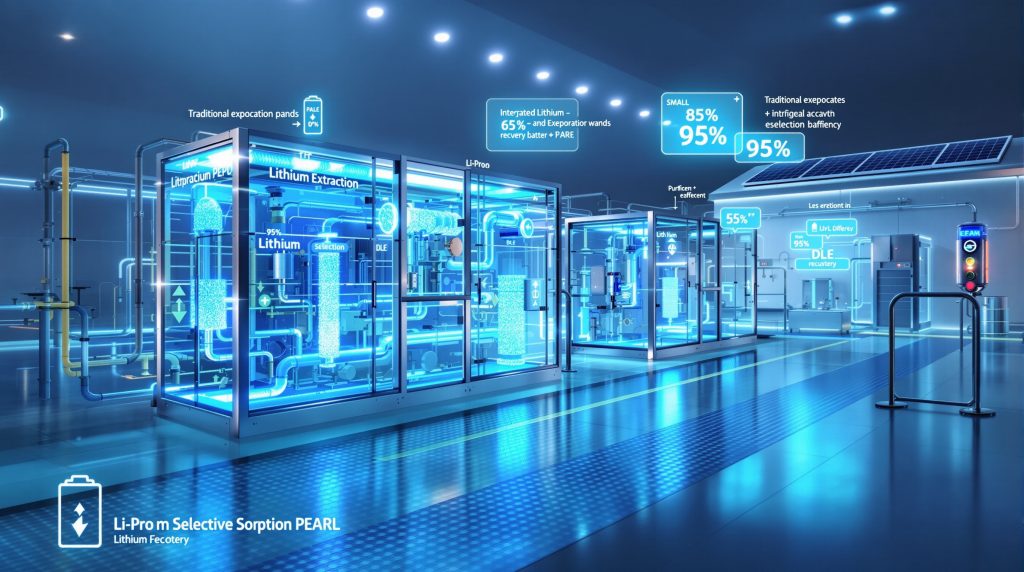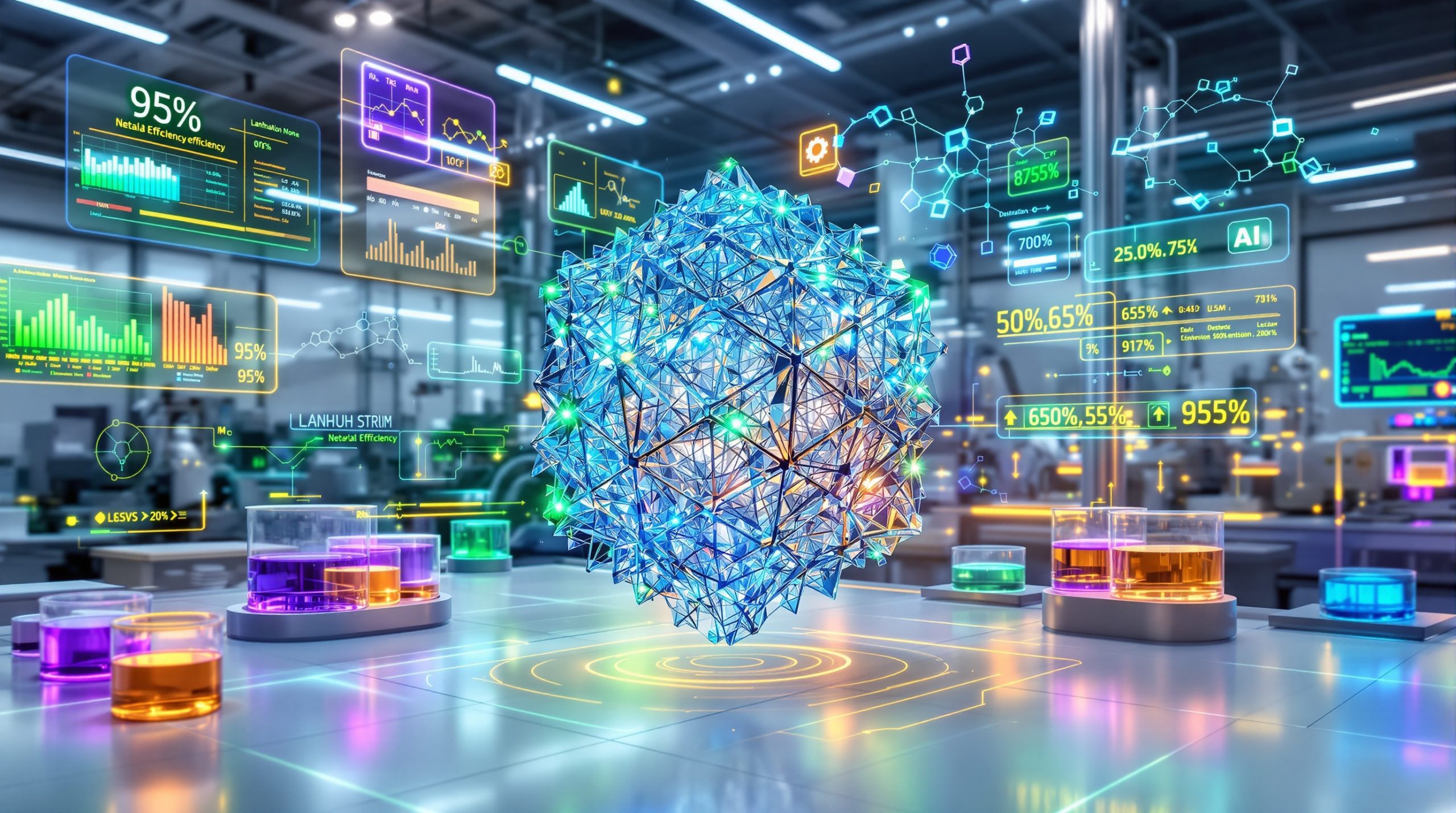What is Direct Lithium Extraction Technology?
Direct Lithium Extraction (DLE) represents a revolutionary approach to lithium production that fundamentally transforms how this critical battery metal is obtained from brine resources. Unlike traditional methods that rely on massive evaporation ponds and lengthy processing times, DLE technologies employ advanced chemical processes to selectively extract lithium ions directly from brine solutions.
The core principle behind DLE involves specialized materials and processes that can selectively capture lithium ions while leaving behind unwanted elements like sodium, calcium, and magnesium. This selectivity is achieved through various approaches including ion exchange resins, specialized adsorbents, and solvent extraction systems designed specifically for lithium's unique chemical properties.
What makes DLE particularly valuable in today's rapidly evolving energy landscape is its potential to address several critical limitations of conventional lithium production. Traditional evaporation methods typically recover only 30-50% of available lithium, whereas advanced DLE technologies can achieve recovery rates exceeding 90% in optimal conditions. This dramatic efficiency improvement could significantly expand the functional lithium supply without requiring new resource discoveries.
Perhaps most importantly for water-stressed regions, DLE dramatically reduces water consumption compared to evaporation ponds. Traditional methods can evaporate millions of gallons of water in arid regions, while DLE systems can operate with minimal water loss and even integrate with water recycling systems for near-closed-loop operations.
The processing timeline advantage is equally significant. Conventional evaporation pond methods require 18-24 months to concentrate lithium, whereas DLE can extract lithium in hours or days, enabling more responsive production scaling to meet market demands.
How Does Aquatech's Acquisition Transform the Lithium Supply Chain?
The Strategic Integration of Upstream and Downstream Capabilities
Aquatech acquires direct lithium extraction technology represents a significant development in the lithium processing technology landscape. By incorporating the Li-Pro™ Lithium Selective Sorption (LSS) technology and associated intellectual property portfolio into its existing PEARL™ process technology platform, Aquatech has created what they claim is the industry's first fully integrated, end-to-end lithium processing solution.
This integration connects previously separate technological domains in the lithium value chain. According to Engineering & Mining Journal (October 2025), the acquisition allows Aquatech to offer a comprehensive solution spanning the entire lithium production process – from initial extraction from brine resources through multiple purification stages to final refining into battery-grade materials.
The technological consolidation addresses a critical fragmentation problem that has plagued lithium project developers. Previously, companies would need to license or develop separate technologies for extraction, purification, and conversion processes, often from different providers with limited compatibility testing between systems.
Vertical Integration Benefits for Project Development
For lithium project developers, this consolidated approach offers several potential advantages that could accelerate new production capacity. First, it significantly reduces technological integration risk – the uncertainty surrounding how well different process technologies will work together at scale. When extraction and refining technologies come from different providers, compatibility issues often emerge during scale-up, leading to costly delays and performance shortfalls.
The unified technology platform can substantially compress project development timelines. Rather than sequentially evaluating and engineering multiple process sections from different providers, developers can implement a pre-integrated solution with established performance parameters. According to industry analysis, this integration could potentially reduce project implementation times by 6-12 months – a critical advantage in the race to meet rapidly growing lithium demand.
From a financial perspective, the integrated approach may improve overall project economics in several ways. Capital efficiency improves through elimination of redundant equipment and infrastructure that often results from piecing together separate technology systems. Operating costs potentially decrease through optimized reagent consumption, energy usage, and maintenance requirements across the unified process chain.
Perhaps most significantly for project financing, the end-to-end solution enhances project bankability. Financial institutions have historically approached novel lithium extraction projects with caution due to technology risk. A proven, integrated technology package with established performance metrics across the full process chain could substantially reduce perceived risk profiles for new projects.
What Makes Li-Pro™ Technology a Game-Changer?
Technical Advantages of Lithium Selective Sorption
The Li-Pro™ LSS technology acquired from Koch represents a specialized approach to lithium extraction focused on selective adsorption mechanisms. While specific performance details weren't provided in the Engineering & Mining Journal article, similar lithium-selective adsorption technologies typically employ advanced materials science to create highly specific binding sites that preferentially attract lithium ions while rejecting competing elements commonly found in brines.
This selectivity is crucial for processing challenging brine resources that contain high levels of interfering elements like magnesium, calcium, and boron. In traditional evaporation processes, these elements complicate downstream processing and reduce lithium recovery rates. A highly selective extraction system that can effectively discriminate between lithium and these contaminants potentially unlocks resources previously considered economically unviable.
The technology's operational durability is another critical factor for commercial implementation. Lithium extraction systems must maintain performance through thousands of adsorption-desorption cycles while exposed to challenging brine chemistries. Technologies that maintain consistent performance without requiring frequent media replacement or regeneration provide significant operational and economic advantages.
Commercial Validation Through Real-World Implementation
For any new extraction technology, the path from laboratory success to commercial viability is challenging and littered with technologies that performed well at small scale but failed to deliver in real-world conditions. The Engineering & Mining Journal article notes that Aquatech's acquisition creates "the only commercially proven, end-to-end flowsheet solution for lithium processing," suggesting that the Li-Pro™ technology has achieved demonstration beyond laboratory or pilot scale.
This commercial validation represents a significant differentiator in the crowded DLE technology landscape. While dozens of companies and research institutions have developed promising DLE approaches, relatively few have successfully operated at scales relevant to commercial lithium production or with real-world brines rather than synthetic solutions.
The ability to maintain performance across varying brine chemistries further distinguishes robust commercial technologies from laboratory curiosities. Lithium brines worldwide exhibit wide variations in total dissolved solids, lithium concentration, and impurity profiles. Technologies that can operate effectively across this spectrum without requiring complete redesign for each application offer significant advantages for widespread adoption.
Why is This Acquisition Strategically Timed?
Market Dynamics Driving Demand for Advanced Lithium Technologies
Aquatech's acquisition of KTS' DLE business occurs against a backdrop of unprecedented growth projections for lithium demand. Industry forecasts consistently show lithium demand increasing dramatically over the coming decades, driven primarily by the electric vehicle revolution and grid-scale energy storage deployment. Projections from various market analysis firms suggest lithium demand could increase 4-6 times from current levels by 2030, with continued growth beyond.
This demand growth is colliding with significant constraints in existing lithium supply infrastructure. Current production capacity falls well short of projected requirements, creating a structural supply deficit that threatens battery manufacturing expansion plans. Traditional lithium sources face increasingly lengthy development timelines due to permitting complexities, environmental concerns, and community opposition to large-scale mining and evaporation operations.
Geographic concentration of lithium production creates additional supply chain vulnerabilities. Traditional lithium sources are heavily concentrated in the "Lithium Triangle" of Chile, Argentine lithium brine insights, and Bolivia, along with Australian hard-rock mining operations. This concentration exposes battery manufacturers and electric vehicle producers to geopolitical risks and potential supply disruptions.
Perhaps most critically, processing bottlenecks represent a major constraint on lithium supply chain expansion. Refining capacity limitations, particularly outside of China, create vulnerability for Western manufacturers aiming to establish more regionalized supply chains. Technologies that can integrate extraction and refining processes into unified operations potentially address this critical bottleneck.
Regulatory and Investment Landscape
Recent policy developments have created a favorable environment for advanced lithium technologies, particularly in North America and Europe. The U.S. Inflation Reduction Act and similar initiatives worldwide have designated lithium as a critical mineral essential for clean energy transition, creating financial incentives and support mechanisms for domestic production.
Clean energy incentive structures increasingly favor production methods with lower environmental footprints. DLE technologies that minimize water consumption, reduce land disturbance, and lower carbon emissions align well with these policy priorities, potentially qualifying for preferential treatment under various green technology funding initiatives.
Environmental, Social, and Governance (ESG) investment criteria are increasingly influencing capital allocation decisions throughout the mining and materials sector. Technologies that demonstrably reduce environmental impacts while delivering positive community outcomes attract both project financing and corporate investment more readily than conventional approaches with larger ecological footprints.
Supply chain resilience has emerged as a strategic priority for governments and manufacturers alike following recent disruptions. Technologies enabling lithium production from unconventional resources or in new geographic regions support diversification objectives and reduce dependency on highly concentrated supply sources.
How Does This Acquisition Compare to Other Industry Developments?
Competitive Positioning in the DLE Landscape
The lithium technology landscape has become increasingly crowded as demand projections have attracted significant investment into alternative extraction methods. Aquatech's integrated approach distinguishes it from many competitors who focus exclusively on the extraction phase without addressing downstream processing requirements.
While numerous companies have developed promising DLE technologies, many remain at laboratory or pilot scale rather than commercial implementation. According to the Engineering & Mining Journal article, Aquatech claims its solution is "commercially proven," potentially placing it ahead of competitors still working through technology validation stages.
A key differentiator in the competitive landscape is the level of integration between process stages. Many DLE providers focus exclusively on the extraction technology, requiring project developers to separately source and integrate downstream processing technologies. Aquatech's end-to-end solution potentially reduces this integration complexity and associated project risks.
Implementation models vary significantly across the DLE landscape. Some providers offer highly standardized, modular solutions aimed at rapid deployment, while others emphasize custom-engineered systems optimized for specific brine chemistries. The flexibility of licensing approaches also varies, with some companies offering technology licenses while others pursue build-own-operate models or joint venture structures.
Notable Projects Incorporating Advanced DLE Technologies
While the Engineering & Mining Journal article doesn't mention specific projects utilizing Aquatech's technology, several major lithium development initiatives worldwide are embracing DLE approaches. These projects serve as important reference points for the commercial viability of advanced extraction methods.
In North America, several companies are developing DLE projects targeting the Smackover Formation, a vast brine resource extending across portions of Arkansas, Texas, and Louisiana. These projects aim to establish significant domestic lithium production capacity leveraging existing oil and gas infrastructure and expertise.
The Salton Sea in California represents another significant DLE opportunity, where companies are developing technologies to extract lithium from geothermal brine extraction as part of renewable energy operations. These projects benefit from existing infrastructure and the potential for zero-carbon lithium production powered by geothermal energy.
Several operations in Nevada's Clayton Valley are implementing or piloting DLE technologies to complement existing operations or develop new resources. These initiatives provide important demonstrations of how advanced extraction methods can be integrated with conventional operations or applied to resources previously considered sub-economic.
South American lithium producers, traditionally reliant on evaporation ponds, are increasingly evaluating DLE technologies to improve recovery rates, reduce water consumption, and accelerate production timelines. This evolution in the industry's traditional heartland indicates growing recognition of DLE's potential advantages even in regions with established production methods.
What Environmental Benefits Does DLE Technology Offer?
Sustainability Advantages Compared to Conventional Methods
DLE technologies deliver substantial environmental improvements compared to traditional lithium production methods, with water conservation representing perhaps the most significant advantage. Conventional evaporation pond operations consume enormous quantities of water in already water-stressed regions – estimates suggest 500,000 gallons of water evaporation per ton of lithium produced. DLE systems can reduce this water consumption by 90% or more through closed-loop designs that minimize evaporative losses.
Land footprint minimization represents another major environmental advantage. Traditional evaporation operations require massive land areas – typically 2,000 to 3,500 acres of evaporation ponds per 20,000 tons of annual lithium production. DLE facilities can achieve comparable production capacity on just 10-20 acres, dramatically reducing habitat disruption and visual impacts.
The time compression from months to hours for lithium recovery has significant environmental implications beyond operational efficiency. Faster processing enables more responsive production management, allowing operations to quickly adjust to changing conditions or pause processing during sensitive environmental periods without major production impacts.
Chemical usage optimization in advanced DLE systems can substantially reduce the environmental footprint of lithium production. Selective extraction reduces the quantity of reagents required to separate lithium from impurities, minimizing chemical consumption and waste generation compared to conventional processing methods that must address all dissolved solids rather than targeting lithium specifically.
Carbon Footprint Considerations
When integrated with renewable energy sources, DLE operations can achieve significantly lower carbon intensities than conventional lithium production. Energy requirements vary considerably between DLE technologies, but advanced designs focused on efficiency can minimize electricity consumption per ton of lithium produced.
The compact physical footprint of DLE facilities creates opportunities for co-location with renewable energy sources that might be impractical for sprawling evaporation operations. Solar installations can directly power extraction operations during daylight hours, while battery storage systems enable continuous processing using stored renewable energy.
Transportation emissions reduction represents an often-overlooked environmental advantage of integrated lithium processing. When extraction, purification, and conversion occur at a single location, intermediate shipping of partially processed materials is eliminated, reducing transportation-related emissions and simplifying the supply chain.
Life cycle advantages extend beyond the production phase to include site remediation and closure. DLE facilities avoid the long-term environmental liabilities associated with large evaporation pond complexes, which can require extensive reclamation efforts and ongoing monitoring for potential brine contamination of groundwater resources.
What Challenges Must Be Addressed for Widespread DLE Adoption?
Technical and Operational Considerations
Despite its advantages, DLE implementation faces several technical hurdles that must be addressed for widespread adoption. Perhaps most significant is performance sensitivity to specific brine compositions. Technologies that perform excellently with one brine chemistry may struggle with others due to interference from competing ions, scaling issues, or fouling mechanisms that reduce efficiency and increase operating costs.
Material durability represents another critical challenge, particularly for adsorption-based systems that must maintain performance through thousands of loading and regeneration cycles. Degradation of selective materials over time can significantly impact economics through increased replacement costs and reduced recovery rates, making long-term performance validation essential for technology selection.
Scale-up complexity introduces numerous engineering challenges when transitioning from demonstration to commercial implementation. Issues including flow distribution, mixing efficiency, and heat transfer that may be manageable at small scale can become significant obstacles in larger systems. Technologies must demonstrate robust performance through this scaling process to achieve commercial acceptance.
Process optimization requires balancing multiple competing objectives including lithium recovery rates, product purity, energy consumption, and reagent usage. Finding the optimal operating point that maximizes economic returns while meeting environmental and quality requirements represents an ongoing challenge requiring sophisticated process control systems and operational expertise.
Economic Factors Influencing Adoption
Capital intensity remains a significant consideration for DLE implementation decisions. While the Engineering & Mining Journal article suggests Aquatech's integrated approach could reduce costs, initial investment requirements for advanced processing systems typically exceed those of conventional evaporation operations on a per-ton basis, though with higher recovery rates and faster payback potential.
Operating cost structures vary substantially between DLE technologies and depend heavily on site-specific factors including energy costs, reagent availability, and labor rates. Technologies with high energy requirements may struggle to achieve competitive economics in regions with expensive electricity, while those dependent on specialized reagents face supply chain and pricing risks.
Technology risk premiums impact financing availability and costs for projects employing novel extraction methods. Even with successful demonstration plants, financial institutions typically apply higher risk adjustments to projects using newer technologies, increasing capital costs and potentially delaying implementation despite technical advantages.
Market competitiveness ultimately determines adoption rates, with DLE technologies needing to deliver competitive production costs against established producers. The cost position achieved depends on numerous factors including resource quality, infrastructure availability, regulatory environment, and technology performance, creating a complex evaluation landscape for project developers.
How Will This Acquisition Impact the Global Lithium Market?
Supply Chain Implications
The integration of extraction and refining technologies could significantly influence lithium supply dynamics by accelerating project development timelines. According to the Engineering & Mining Journal article, Aquatech claims its integrated approach will "accelerate project schedules," potentially enabling faster capacity expansion to address projected supply shortfalls.
Geographic diversification of lithium production represents another potential impact of advanced processing technologies. DLE systems capable of economically processing lower-grade or more complex brines could enable production in regions previously considered uncompetitive with traditional lithium sources, reducing concentration risks in global supply chains.
Product quality consistency may improve through integrated processing systems that maintain tighter control throughout the production chain. Battery manufacturers increasingly demand consistent, high-purity lithium compounds to ensure battery performance and safety, creating premium opportunities for producers who can deliver reliable quality.
Supply security enhancement through technology diversification represents a strategic benefit for battery manufacturers and electric vehicle producers. Reducing dependency on evaporation-based production, which remains vulnerable to climate impacts and water availability concerns, creates more resilient supply chains less susceptible to disruption.
Market Structure Evolution
Technology licensing models may evolve as integrated solutions gain market acceptance. The traditional separation between extraction and conversion technologies could give way to comprehensive solution providers offering end-to-end technology packages with performance guarantees covering the entire production chain.
Project development approaches may shift toward more streamlined pathways incorporating pre-engineered technology modules rather than custom-designed processes for each step. This evolution could reduce development costs and timelines while improving predictability of both capital requirements and operational performance.
Value chain positioning could see significant reconfiguration as technology providers expand their roles beyond equipment supply to include ongoing technical support, performance optimization, and potentially even operational involvement through joint ventures or service agreements.
Industry consolidation patterns may accelerate as technology providers seek to build comprehensive capabilities through strategic acquisitions. The Aquatech-KTS transaction represents one example of this trend, as companies position themselves to offer more complete solutions to an industry demanding faster deployment and reduced implementation risk.
What Does the Future Hold for Integrated Lithium Technologies?
Emerging Trends and Innovations
The Aquatech acquisition represents part of a broader evolution in lithium processing that continues to accelerate through ongoing research and development. Next-generation selectivity improvements focus on developing extraction mechanisms with even greater specificity for lithium, potentially unlocking resources currently considered too contaminated with interfering elements for economic recovery.
Process intensification represents another major innovation direction, with engineering advancements aimed at reducing equipment size, energy requirements, and reagent consumption while maintaining or improving recovery rates. These developments could further decrease both capital costs and operational expenses, expanding the range of economically viable resources.
Circular economy integration is gaining increasing attention, with technology developers exploring opportunities to recover additional valuable elements from brine streams as co-products or byproducts. Comprehensive resource utilization could significantly improve overall project economics while reducing waste generation and environmental impacts.
Digital optimization through advanced control systems, machine learning algorithms, and predictive maintenance approaches offers substantial performance improvement potential. These technologies enable real-time process adjustments to accommodate variations in feed composition, optimize reagent usage, and maximize recovery rates while maintaining product quality specifications.
Long-Term Industry Transformation Potential
Integrated technologies may fundamentally reshape lithium production economics by enabling viable extraction from previously marginal resources. Brines with lower lithium concentrations, higher impurity levels, or more complex chemistries could become economically attractive with highly selective, efficient processing systems, potentially expanding the global resource base.
Production flexibility represents a significant advantage of advanced processing systems over traditional evaporation operations. DLE facilities can adjust production rates much more responsively to market conditions compared to evaporation ponds, which operate on much longer cycles and have limited ability to modulate output without significant disruption.
Value addition opportunities may expand through technologies enabling direct production of specialized lithium compounds or precursor materials customized for specific battery chemistries. This vertical integration could capture additional value compared to producing standard lithium carbonate or hydroxide commodities.
Sustainability leadership could emerge as a major competitive differentiator as battery manufacturers and electric vehicle producers increasingly prioritize environmentally responsible material sourcing. Technologies that demonstrably reduce water consumption, land disturbance, and carbon emissions may command premium pricing or preferential supply agreements in an increasingly ESG-conscious market.
FAQs About Aquatech's DLE Technology Acquisition
What exactly did Aquatech acquire from Koch Technology Solutions?
Aquatech acquired Koch Technology Solutions' direct lithium extraction business, including the Li-Pro™ Lithium Selective Sorption technology and the Li-Pro™ Gen II intellectual property portfolio. This acquisition complements Aquatech's existing PEARL™ process technology platform, creating what the company describes as an end-to-end lithium processing solution spanning extraction, purification, and refining stages.
How does this acquisition benefit lithium project developers?
Project developers gain access to a comprehensive technology solution that addresses the entire lithium production chain rather than just individual process segments. According to Engineering & Mining Journal (October 2025), this integration can "improve project bankability by removing process risk, accelerating project schedules, and reducing the total cost of lithium production." The unified approach eliminates compatibility concerns between different technologies and simplifies implementation.
What makes DLE technology more sustainable than traditional methods?
DLE technologies offer several sustainability advantages compared to conventional evaporation-based lithium production. These include dramatically reduced water consumption (up to 90% less), minimal land disturbance (10-20 acres versus thousands for equivalent production), accelerated processing times (hours versus months), and significantly lower chemical usage through selective extraction processes. When powered by renewable energy, DLE operations can also achieve substantially lower carbon intensity.
Is this technology commercially proven?
According to Engineering & Mining Journal (October 2025), Aquatech claims its integrated platform is "commercially proven," suggesting the technology has progressed beyond laboratory and pilot stages to demonstration or commercial implementation. However, specific performance metrics and operational history details weren't provided in the source material.
How might this acquisition affect lithium prices and availability?
While specific market impact projections weren't provided in the source material, integrated technologies that streamline project development potentially accelerate new production capacity additions. If successfully implemented across multiple projects, this could help address projected supply shortfalls and potentially moderate price volatility by bringing new production online more quickly than conventional approaches. Improved recovery rates from existing resources could also expand effective supply without requiring new discoveries.
Further Exploration:
Readers interested in learning more about developments in lithium extraction technology can also explore related educational content about Australia lithium innovations or the development of a new battery-grade lithium refinery in India. Furthermore, those following major lithium mining projects might want to learn about progress at the Thacker Pass lithium mine in the United States.
Looking to Invest in Lithium Processing Technology Innovations?
Discover investment opportunities in the evolving lithium extraction landscape with Discovery Alert's proprietary Discovery IQ model, which provides instant notifications on significant ASX mineral discoveries including those utilising revolutionary DLE technology. Visit https://discoveryalert.com.au/discoveries/ to explore how major mineral discoveries can generate substantial returns and position yourself ahead of the market.




